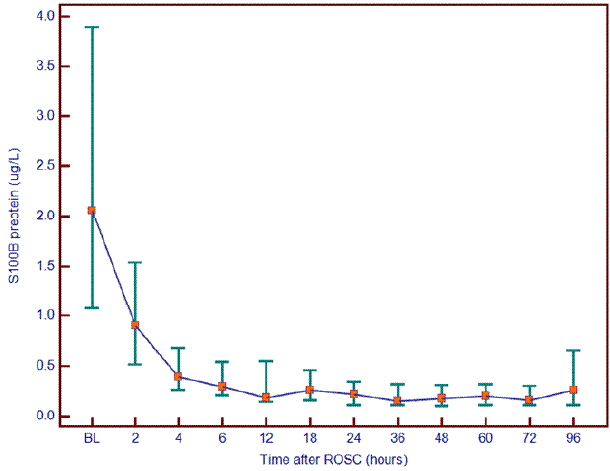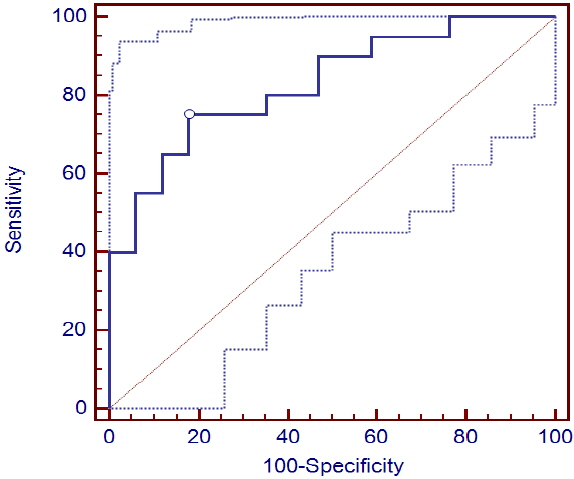Korean J Crit Care Med.
2014 Nov;29(4):304-312. 10.4266/kjccm.2014.29.4.304.
Prognostic Value and Optimal Sampling Time of S-100B Protein for Outcome Prediction in Cardiac Arrest Patients Treated with Therapeutic Hypothermia
- Affiliations
-
- 1Department of Emergency Medicine, Gachon university Gil Medical Center, Incheon, Korea. yongem@gilhospital.com
- KMID: 2227738
- DOI: http://doi.org/10.4266/kjccm.2014.29.4.304
Abstract
- BACKGROUND
The aim of this study was to determine the prognostic value and optimal sampling time of serum S-100B protein for the prediction of poor neurological outcomes in post-cardiac arrest (CA) patients treated with therapeutic hypothermia (TH).
METHODS
We prospectively measured serum S100 calcium binding protein beta subunit (S-100B protein) levels 12 times (0-96 hours) after the return of spontaneous circulation (ROSC). The patients were classified into two groups based on cerebral performance category (CPC): the good neurological outcome group (CPC 1-2 at 6 months) and the poor neurological outcome group (CPC 3-5). We compared serial changes and serum S-100B protein levels at each time point between the two groups and performed receiver operating characteristic curve analysis for the prediction of poor neurological outcomes.
RESULTS
A total of 40 patients were enrolled in the study. S-100B protein levels peaked at ROSC (0 hour), decreased rapidly to 6 hours and maintained a similar level thereafter. Serum S-100B protein levels in the poor CPC group (n = 22) were significantly higher than in the good CPC group (n = 18) at all time points after ROSC except at 4 hours. The time points with highest area under curve were 24 (0.829) and 36 (0.837) hours. The cut-off value, the sensitivity (24/36 hours) and specificity (24/36 hours) for the prediction of poor CPC at 24 and 48 hours were 0.221/0.249 ug/L, 75/65% and 82.4/94.1%, respectively.
CONCLUSIONS
Serum S-100B protein was an early and useful marker for the prediction of poor neurological outcomes in post-CA patients treated with TH and the optimal sampling times were 24 and 36 hours after ROSC.
MeSH Terms
Figure
Cited by 1 articles
-
Management of post-cardiac arrest syndrome
Youngjoon Kang
Acute Crit Care. 2019;34(3):173-178. doi: 10.4266/acc.2019.00654.
Reference
-
References
1). Sasson C, Rogers MA, Dahl J, Kellermann AL. Predictors of survival from out-of-hospital cardiac arrest: a systematic review and meta-analysis. Circ Cardiovasc Qual Outcomes. 2010; 3:63–81.2). Nolan JP, Laver SR, Welch CA, Harrison DA, Gupta V, Rowan K. Outcome following admission to UK intensive care units after cardiac arrest: a secondary analysis of the ICNARC case mix programme database. Anaesthesia. 2007; 62:1207–16.
Article3). Lee MG, Kim SJ, Choi DH, Jun DH, Yoo BD, Lee DP. Outcome of nontraumatic prehospital cardiac arrest. J Korean Soc Emerg Med. 2002; 13:428–33.4). Kim SE, Eo EK, Cheon YJ, Jung KY, Park HS. Outcome in a tertiary emergency department for cardiopulmonary resuscitation for out-of-hospital cardiac arrest. J Korean Soc Emerg Med. 2005; 16:495–504.5). Park KN, Choi SP, Lee MJ, Kim YM, Choi KH, Sung CH, et al. Clinical course of hypoxic-ischemic coma after cardiopulmonary resuscitation in Korea. J Korean Soc Emerg Med. 2005; 16:327–33.6). Nolan JP, Neumar RW, Adrie C, Aibiki M, Berg RA, Bbttiger BW, et al. Post-cardiac arrest syndrome: epidemiology, pathophysiology, treatment, and prognostication: a scientific statement from the international liaison committee on resuscitation; the American heart association emergency cardiovascular care committee; the council on cardiovascular surgery and anesthesia; the council on cardiopulmonary, perioperative, and critical care; the council on clinical cardiology; the council on stroke. Resuscitation. 2008; 79:350–79.7). Madl C, Grimm G, Kramer L, Yeganehfar W, Sterz F, Schneider B, et al. Early prediction of individual outcome after cardiopulmonary resuscitation. Lancet. 1993; 341:855–8.
Article8). Hypothermia after Cardiac Arrest Study Group. Mild therapeutic hypothermia to improve the neurologic outcome after cardiac arrest. N Engl J Med. 2002; 346:549–56.9). Bernard SA, Gray TW, Buist MD, Jones BM, Silvester W, Gutteridge G, et al. Treatment of comatose survivors of out-of-hospital cardiac arrest with induced hypothermia. N Engl J Med. 2002; 346:557–63.
Article10). Wijdicks EF, Hijdra A, Young GB, Bassetti CL, Wiebe S; Quality Standards Subcommittee of the American Academy of Neurology. Practice parameter: prediction of outcome in comatose survivors after cardiopulmonary resuscitation (an evidence-based review): report of the quality standards subcommittee of the American academy of neurology. Neurology. 2006; 67:203–10.
Article11). Tiainen M, Roine RO, Pettilä V, Takkunen O. Serum neuron-specific enolase and S-100B protein in cardiac arrest patients treated with hypothermia. Stroke. 2003; 34:2881–6.
Article12). Hachimi-Idrissi S, Zizi M, Nguyen DN, Schiettecate J, Ebinger G, Michotte Y, et al. The evolution of serum astroglial S-100 beta protein in patients with cardiac arrest treated with mild hypothermia. Resuscitation. 2005; 64:187–92.13). Derwall M, Stoppe C, Brücken D, Rossaint R, Fries M. Changes in S-100 protein serum levels in survivors of out-of-hospital cardiac arrest treated with mild therapeutic hypothermia: a prospective, observational study. Crit Care. 2009; 13:R58.14). Rundgren M, Karlsson T, Nielsen N, Cronberg T, Johnsson P, Friberg H. Neuron specific enolase and S-100B as predictors of outcome after cardiac arrest and induced hypothermia. Resuscitation. 2009; 80:784–9.
Article15). Wennervirta JE, Ermes MJ, Tiainen SM, Salmi TK, Hynninen MS, Särkelä MO, et al. Hypothermia-treated cardiac arrest patients with good neurological outcome differ early in quantitative variables of EEG suppression and epileptiform activity. Crit Care Med. 2009; 37:2427–35.
Article16). Mörtberg E, Zetterberg H, Nordmark J, Blennow K, Rosengren L, Rubertsson S. S-100B is superior to NSE, BDNF and GFAP in predicting outcome of resuscitation from cardiac arrest with hypothermia treatment. Resuscitation. 2011; 82:26–31.
Article17). Stammet P, Wagner DR, Gilson G, Devaux Y. Modeling serum level of S-100β and bispectral index to predict outcome after cardiac arrest. J Am Coll Cardiol. 2013; 62:851–8.18). Zellner T, Gärtner R, Schopohl J, Angstwurm M. NSE and S-100B are not sufficiently predictive of neurologic outcome after therapeutic hypothermia for cardiac arrest. Resuscitation. 2013; 84:1382–6.
Article19). Gray WA, Capone RJ, Most AS. Unsuccessful emergency medical resuscitation--are continued efforts in the emergency department justified? N Engl J Med. 1991; 325:1393–8.20). Hamel MB, Phillips R, Teno J, Davis RB, Goldman L, Lynn J, et al. Cost effectiveness of aggressive care for patients with nontraumatic coma. Crit Care Med. 2002; 30:1191–6.
Article21). Geocadin RG, Buitrago MM, Torbey MT, Chandra-Strobos N, Williams MA, Kaplan PW. Neurologic prognosis and withdrawal of life support after resuscitation from cardiac arrest. Neurology. 2006; 67:105–8.
Article22). Booth CM, Boone RH, Tomlinson G, Detsky AS. Is this patient dead, vegetative, or severely neurologically impaired? Assessing outcome for comatose survivors of cardiac arrest. JAMA. 2004; 291:870–9.23). Schäfer BW, Heizmann CW. The S100 family of EF-hand calcium-binding proteins: functions and pathology. Trends Biochem Sci. 1996; 21:134–40.
Article24). Heizmann CW, Fritz G, Schäfer BW. S100 proteins: structure, functions and pathology. Front Biosci. 2002; 7:d1356–68.
Article
- Full Text Links
- Actions
-
Cited
- CITED
-
- Close
- Share
- Similar articles
-
- The Effect of Mild Therapeutic Hypothermia on the non-Vf Cardiac arrest
- Clinical Implementation of Therapeutic Hypothermia after Cardiac Arrest
- The Analysis of Factors Related to Reaching to Therapeutic Range in Patients with Receiving Therapeutic Hypothermia after Return of Spontaneous Circulation after Out-of hospital Cardiac Arrest
- Implementation of Therapeutic Hypothermia after Pediatric Out-of Hospital Cardiac Arrest in One Tertiary Emergency Center
- Neuron Specific Enolase as a Biomarker Predicting Neurological Outcome after Cardiac Arrest in Patients Treated by Therapeutic Hypothermia





